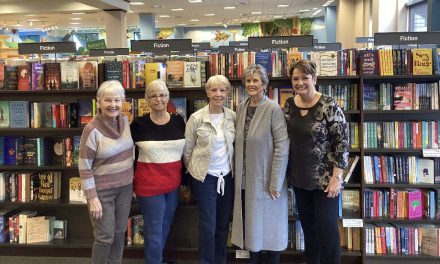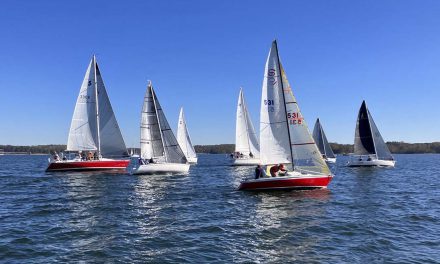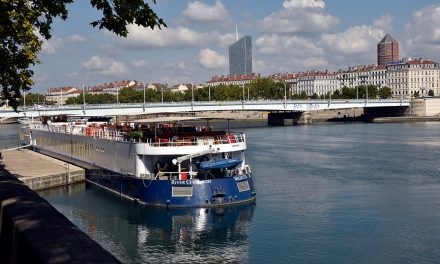In January, Lakeside News’ senior reporter traveled to Morocco. Overlooking the Mediterranean Sea and the Atlantic Ocean, it’s bisected by the Atlas Mountains, bordered by Algeria on the east and shares the Sahara Desert with about a half-dozen African countries. Known by most Americans as the setting for the movie “Casablanca,” the country’s intrigue and mystery would unfold as she dug deep into their amazing culture. This month, Pam explores the Sahara Desert, including visiting a successful date farmer who has unraveled the secrets of an otherwise-dry desert, and comes back down from the High Atlas Mountains to the legendary Casablanca.
The excitement built as our band of seven made preparations to spend two nights in the Sahara. We transferred only the luggage we would need for the two-night stay and traded our 17-passenger van for two four-wheel SUVs.
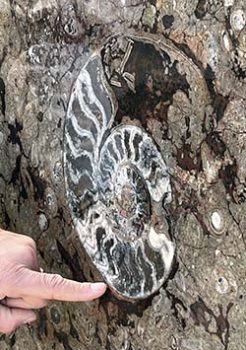
An example of the many fossils found in the rocks.
We actually swapped vehicles in the town of Erfoud, at the edge of the Sahara Desert. Known for its Museum of Fossils and Minerals and the many fossil factories that mine these pre-historic treasures, Erfoud is an oasis town that some call the “Gateway to the Sahara.”
It’s not that impressive, until we realized the we were standing where the ancient Saharan seaway stretched across what we now know as the Sahara Desert. The proof is in the results of many generations of Berber families who continue to mine and restore large pieces of stone filled with fossilized trilobites, chambered nautilus, horseshoe crabs and intricate, delicate remains of graceful jellyfish that look like crystalized ferns.
One of the managers gave us a quick tour for first-hand views of the workmanship that goes into the hand-dug chunks of stone to reveal these pre-historic animals. Workers cleaned and chiseled the large slabs of stone by hand, then polished them to be purchased by collectors as stand-alone sculptures or tables. They were stunning.
Then it was on to the most intriguing part of the adventure for me: two nights under the stars deep within the desert. We drove for several hours over low dunes of rust-colored sand before arriving at the Overseas Adventure Travel camp: 12 semi-permanent tents with real beds, very nice bathrooms and heated foot warmers to keep us toasty at night.
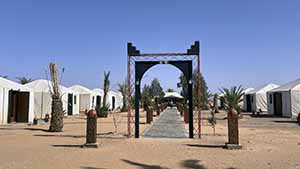
Home Camp
The camp staff, including a cook, kitchen assistant and several others, saw to our every need with hot coffee to take off the 35-degree overnight chill to meals that included the traditional tajine and plenty of Moroccan bread. Desserts were yummy.
Camel rides on the agenda for our first day allowed us more than 90 minutes to go even deeper into the desert where we dismounted and rested on the fine desert sand to listen to the deafening silence of the isolation. We were disrupted by a group of ATV riders about a mile away who looked like gnats as they scooted across the dunes.
Our second Sahara day included a stop at a local community center for a performance by traditional Moroccan musicians playing drums, heavy castanets and three-stringed lutes.
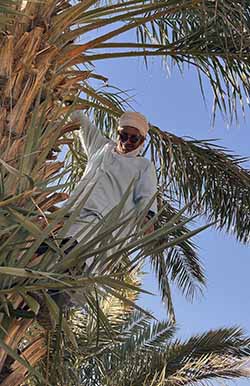
View from a Date tree.
The day’s highlight – a journey to a family farm. The 68-year-old date farmer shared with us the secrets of growing dates and produce in the arid desert. He had worked out an arrangement with the government to tap into one of the many cisterns for irrigation, expanding the water’s reach by way of a very effective drip system with water being fed into the fields from each end.
His date farm – 150 female date trees and one male tree – keeps him busy most of the season, climbing each tree to hand-pollinate the female trees after scaling the 20-foot male tree to retrieve pollen-laden flowers. He also grew carrots, lettuce, spinach and a variety of fruits, not only to feed his family but also to take to market.
The next morning, we packed up to begin the final legs of our journey. We again crossed the High Atlas Mountains at more than 7,000 feet above sea level, with the landscape becoming increasingly green.
One of OAT’s signature activities, we spend “A Day in the Life” of a multi-generational farm family, walking into the fields for a presentation by the local school children, then returning to the home for fresh-made cous cous and a special tajine meal.
OAT and Grand Circle Travel are also known for the positive support the company and its travelers bring to communities around the world. More than 500 projects in 50 countries have been supported by more than $250 million donated by travelers and the Lewis family who owns the two companies. A portion of each trip is also donated to the Foundation.
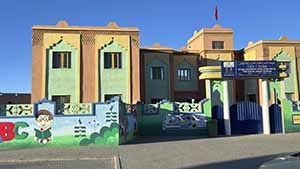
Colorful and bright, many of the schools incorporate Moroccan architectural features.
Projects range from building bathrooms and helping furnishing classrooms in remote countries to installing storage for clean water and supporting women’s programs to help them learn to create self-sufficient businesses.
Since 2016, Grand Circle has funded the Imik Simik Women’s Association for Rural Development, creating workshops and programs to teach girls and women how to cook, sew, read, develop healthcare and other skills. The association is now managed by the local women, who have also created a business selling fresh-baked cookies, pastries and bread to local guesthouses in the village.
As we neared the end of our 15-day journey, we headed to Marrakesh, a teeming city with two distinct cultures: the chaotic life of the medina (the old walled city) and the modern city where international business and industry take place daily.
For two nights, we stayed within the old city walls at another riad, immersing ourselves in the daily lives of street merchants selling spices, pottery, clothing, leather goods and traditional foods.
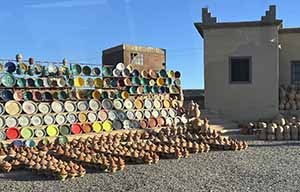
Pottery in Morocco.
A pre-dawn hot-air balloon ride about 45 minutes drive from the riad allowed three of us to have a bird’s-eye view of the expansive countryside, dotted with clay/adobe-type houses; some even had beautiful blue swimming pools. After the ride, a buffet breakfast fueled us for the day.
More exploration in the old town lent itself to shopping for colorful scarves, hand-carved wood items and a fabulous roasted lamb lunch. Cooked in a pit 10 feet in the ground, the lamb was tender and tasty. Of course, we ate like Moroccans, using our fingers as utensils. The old slogan for Kentucky Fried Chicken comes to mind.
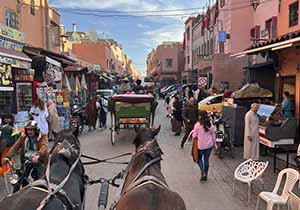
Mixing the old and the new.
The next morning we drove to our final destination: Casablanca. Here’s where the truth was told.
There were no film sets to visit to relive the iconic 1942 film starring Humphrey Bogart and Ingrid Bergman. The movie was completely created on Hollywood sound stages. The only hint of Rick’s Café is a modern-day restaurant inspired by the film; it opened in 2004. It’s usually filled with tourists who want to check an item off their bucket list.
However, it seems we saved the best for last. The Hassan II Mosque in Casablanca, built right next to the Atlantic Ocean, is the largest in Morocco, the second-largest functioning mosque in Africa and the 14th-largest in the world. Its minaret is nearly 690 feet tall, the tallest in the world.
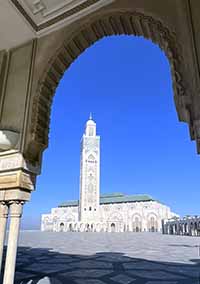
Casablanca’s Hassan II Mosque is the second-largest in Africa. Its minaret is nearly 657 feet tall.
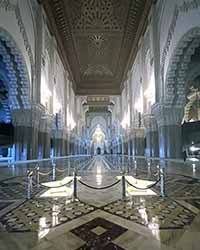
Light floods into the Mosque reflecting off the shiny floors.
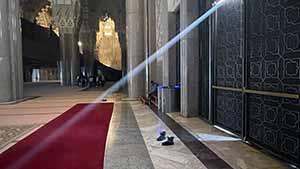
Casablanca’s Hassan II Mosque
Designed by French architect Michel Pinseau, construction began mid-summer 1986 and took seven years to build. It’s the only mosque in Morocco that allows non-Muslims entry.
Soaring painted and carved wood ceilings, detailed mosaics, intricately patterned tile floors, hand-crafted marble walls and a retractable roof are just a few of the elements of this amazing testament to the heritage and culture of Morocco. Visiting the Hassan II Mosque was worth the wait.
And wait I did to make my way to Morocco, and I’m so glad I took this journey instead of the one-day visit to Morocco during my Iberian Peninsula trip right after Covid. As we made our way around the coast of Portugal and Spain, traveling on the 80-passenger Clio in the Grand Circle Fleet through the Strait of Gibraltar, we were denied entrance because of the pandemic.
At the time, I was disappointed, although we instead visited the tiny Spanish territory of Ceuta in northern Africa. After hearing from so many friends who had visited Morocco, sharing the sense of adventure, the beauty of the country – so different from other parts of the world – and the kindness and genuineness of the people, it was a trip I needed to experience for myself.
The trip was way too short, but the memories continue to stay with me. Would I go back? Now, what do you think?
Photos: by Pamela A. Keene


